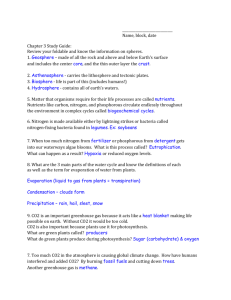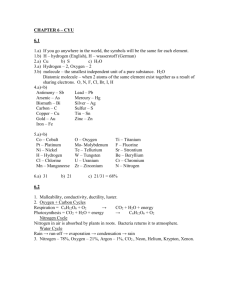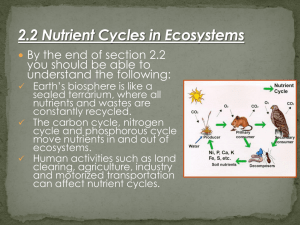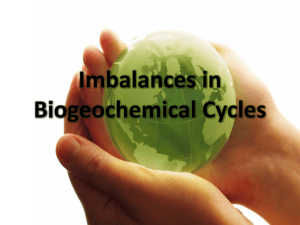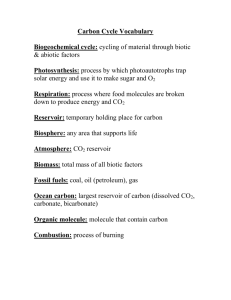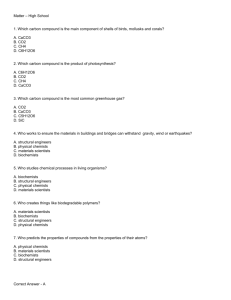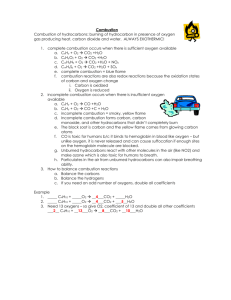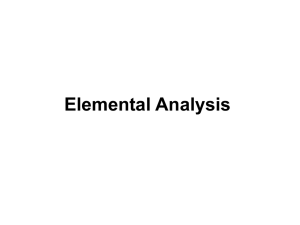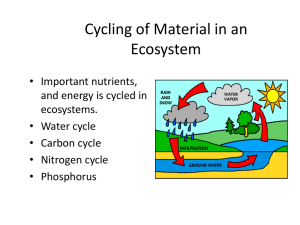Biogechemical Cycles
advertisement
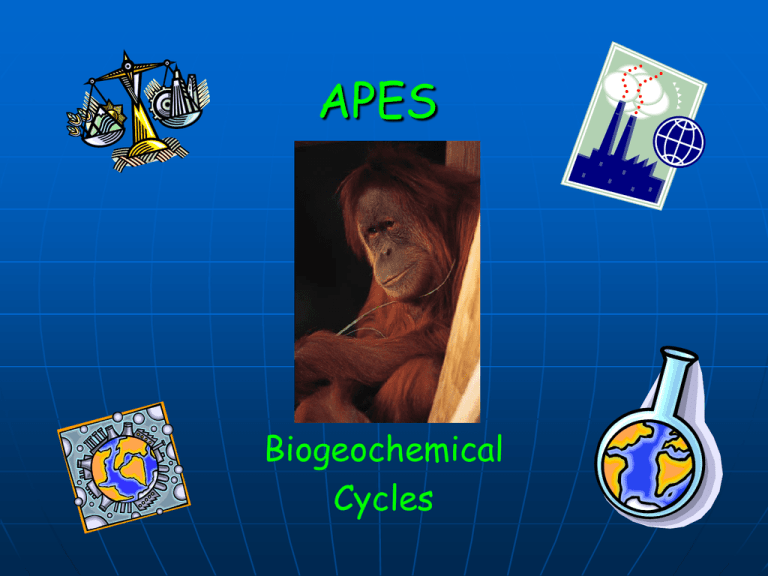
APES Biogeochemical Cycles Nutrient Cycling – Biogeochemical Cycles Building blocks of life macronutrients (CHOPNS) Types of Cycles • Carbon base for organic life forms; carbohydrates, proteins, nucleic acids, lipids • Hydrogen hydrogen bonding (only with N, O, and F) • Oxygen aerobic respiration • Phosphorus limiting factor in aquatic systems; teeth and bones; ATP • Nitrogen DNA, proteins; plant nutrient; limiting factor in marine systems • Sulfur DNA, proteins • Gaseous C, O, N, S, H2O • Sedimentary P Carbon Cycle Photosynthesis - main mechanism to fix carbon into a useable form • • Chemosynthesis • CO2 + S2- + H2O (CH2O)n + SO42- Aerobic Respiration • • hn CO2 + H2O C6H12O6 + O2 Energy is consumed, carbohydrates are produced, oxygen is given off as a waste product C6H12O6 + O2 --- CO2 + H2O Energy is produced, oxygen is consumed and CO2 is put back into the atmosphere Average Residence Time • • • Atmosphere 3 years (mainly as CO2 gas) Soils 25 – 30 years (Carbonate sediments, rocks) Ocean 1500 years (marine sediments, oceans) Human Impacts on the Carbon Cycle Combustion of Fossil Fuel • Hx Cy + O2 CO2 + H2O (Complete combustion) • Deforestion Loss of a carbon sink Slash and burn techniques New Carbon vs. Old Carbon Climate Change • Warmer oceans – may release more CO2, increases in CO2 can increase the acidity of the oceans • Warming permafrost can release more CH4 Carbon dioxide Concentrations Carbon Cycle with Global Flux Nitrogen Cycle Major store – atmosphere (molecular nitrogen – N2) Limiting nutrient in marine ecosystems Nitrogen fixation – atmospheric nitrogen is converted into NH3 • • Abiotic - N2O, HNO3 Biotic Nitrification (NH3 to NO2- to NO3-) • • Rhizobium bacteria – found in the root nodules of legumes Azotobacter Cyanobacteria Nitrosomas – ammonia to nitrite ions Nitrobactor – nitrite to nitrate ions Assimilation • • Ammonium and nitrate ions by plants through their roots. DNA, proteins, amino acids (ionic) Animals assimilate nitrogen by eating plants (organic) Nitrogen Cycle Con’t Ammonification • • Denitrification – anaerobic bacteria • • Nitrogenous wastes and organic matter are broken down by decomposers NH3 is produced Ammonia and nitrates are broken down by denitrifying bacteria N2 and N2O are produced Human Impacts • • • • Combustion of fossil fuel –NOx photochemical smog, acid rain Fertilizers (Haber cycle) – nitrogen runoff, excess nutrients eutrophication algae blooms dead algae are decomposed declines in DO potential death of fish; N2O into the atmosphere N2O is both a greenhouse gas and an ozone depleting compound Planting excessive nitrogen-fixing crops Runoff from feedlots - manure N2 Cycle with Fluxes Increases in Nitrogen due to Anthropogenic Sources Sulfur Cycle Gaseous Cycle Major Store – rocks – Fe2S or CaSO4 Natural Sources • Volcanoes – SO2 H2 SO4 • DMS – dimethyl sulfide from the ocean • H2S from decay Human Impacts • Combustion of coal and petroleum release SOx leads to the formation of H2SO4 contributes to the formation of acid rain • Smelting operation • Ice core samples large increase in S since the industrial revolution Sulfur Cycle Phosphorous Cycle Sedimentary Cycle Major Stores • Phosphate rock • Marine sediments Mined as the mineral apatite – Ca3(PO4)2 (largest mine near Tampa, FL) Guano Limiting nutrient in freshwater ecosystems Fixed by mycorrihizae fungi (keystone species) Human impacts • Removing phosphorous faster then it can be replenished in through the phosphorous cycle – non renewable resource • Fertilizers Excess nutrients eutrophication algae blooms dead algae are decomposed declines in DO potential death of fish • Phosphate containing detergents Phosphorous Cycle with Fluxes Hydrologic Cycle •Driven by the sun and gravity •71% of the earth’s surface is covered by water •~97 % is salt water (average salinity is 35 ppt or 3.5% •~3% is fresh water •~.024% is available for consumption •Evaporation (conversion of water into water vapor) •Transpiration (evaporation from leaves (stoma) of water extracted from soil by roots and transported throughout the plant) •Condensation (conversion of water vapor into droplets of liquid water •Precipitation (rain, sleet, hail, snow) Hydrologic Cycle Con’t Human Impacts • • • Groundwater Depletion Clearing Vegetation Dams and water diversion projects Infiltration (movement of water into soil) Percolation (downward flow of water through soil and permeable rock formations to groundwater storage areas called aquifers Runoff (downslope surface movement back to the sea to resume the cycle) Hydrologic Cycle Hydrologic Cycle with Human Impacts Any Questions? Consultant Code : 1113 Event Code: 3071101283 Session Number : 05
